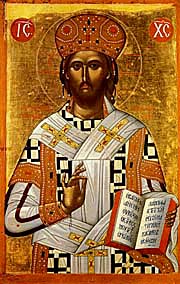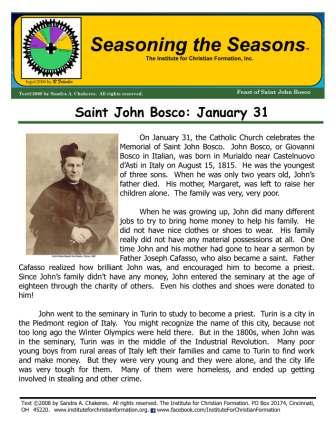The Institute for Christian Formation


Loyola Press has a very short skit about John Bosco, and here is a St. John Bosco Novena from the Salesians. Typically prayed January 22-30, in preparation for John’s feast day, this novena can be prayed at any time for nine days.
2015 is the bicentennial of Saint John Bosco’s birth, and for this occasion the Salesian Missions published a special edition magazine, which you can download here.
Let us conclude our reflection on the life of Saint John Bosco with the short video below. There are no spoken words and the written notation is not in English, but the video is interesting because of the photos and images of Saint John Bosco.
Saint John Bosco
Feast Day (Memorial): January 31
Follow us on Facebook to keep up to date with our news and newest resources!
On January 31, the Catholic Church celebrates the Memorial of Saint John Bosco, Priest. John Bosco, or Giovanni Bosco in Italian, was born in Murialdo near Castelnuovo d’Asti in Italy on August 15, 1815. His parents, Francis and Margaret, were farmers. John was the youngest of three sons. His older brothers were Anthony and Joseph. John was not yet even two years old when his father died. There was also a terrible drought in the region and the family, like others in the area, found it very difficult to get by.
John’s mother was very devout and was a great influence on John’s spiritual upbringing. She truly lived her faith in her domestic church – her home – teaching John to pray and preparing him for the sacrament of penance.

John was a dreamer – literally! When he was only nine years old he had a dream which had a profound influence on his life. You can view a video about this dream below.
Even as a boy, John had a talent for storytelling and entertaining others. He learned tricks from traveling acrobats and magicians, and both youth and adults came to hear and watch him. He used to combine these “performances” with prayer, beginning and ending these gatherings by praying the Sign of the Cross and the Hail Mary.
At the age of eleven, John celebrated his First Communion. It was also around this time that John met the first of a number of priests who would be very influential in his life. Recall that John’s father was dead and his mother did not have the means to pay for his education. While walking on the road returning from attending a mission John met Father Calosso who ended up arranging for John’s education. But John’s brother, Anthony, caused some problems as he was not happy with this arrangement and didn’t feel that John was pulling his weight at home. So John went to live with the priest for his studies during the day, and then returned home to sleep. But in 1828, John suffered another loss in his life when Father Calosso had a stroke and died.
Father Cafasso was another very influential priest in John’s life. John was twelve years old when he met Father Cafasso, who was a seminarian at the time.
When John was thirteen, he enrolled in elementary school. He lodged with a tailor named John Roberto. In this environment John learned both plain chant and the art of tailoring. But in 1830 John’s teacher was transferred and his replacement did not seem capable of keeping order. So John was sent to the city of Chieri to continue school. There he lodged with a widow, Lucy, who was from his home town.
With his entertaining ways, John had always been one to attract others to him. As boys flocked to be around him, a society of sorts was founded – The Society for a Good Time. Each member was required to contribute to the happiness of all the members. The rules of the society included avoiding unchristian language and behavior and being dedicated to scholastic and religious duties.
One of the youth John met and became good friends with was Louis Comollo.
John once again had to move to new lodging, and this time he ended up being a waiter and bartender of sorts. He also became known as a conjurer because of his magic tricks.
Once he decided on a vocation to the priesthood, John was to enter the Franciscan order. But then he had another dream which influenced his life, and he decided to become a secular priest instead. He put on the habit in 1834 and entered the seminary in 1835. Just a few years later John suffered another loss when on April 2, 1839, his good friend, Louis Comollo, died.
In 1841 John was ordained a deacon and then a priest. He had a gift for preaching and enjoyed teaching catechism to youth. Later that same year, John enrolled at the Convitto Ecclesiastico to study moral theology and homiletics. His mentor, Father Cafasso, often visited prisons and would take John with him to visit the prisoners.

The plight of young adults who needed help, especially those just released from prison, paved the way for the beginning of the Oratory on December 8, 1841. In 1844 John became the director of the Little Hospital of St. Philemena and worked in the Refuge. The Oratory then moved to Valdocco. At this time, John had another powerful dream, which seemed to be a sequel to the dream he had at nine years of age.
The first Oratory church was founded, and was named after Saint Francis de Sales, whose patronage this ministry was placed under. This chapel was
blessed on December 8, 1844. In the summer of 1845 the Oratory moved again, this time to the Church of St. Martin at Great Mills (the public mills). Numerous youth attended the gatherings. But soon the local people filed a complaint. So the gatherings moved again and began to be held at the church and courtyard of the Cemetery of Christ Crucified, which was known as St. Peter in Chains. But problems rose again when the chaplain’s housekeeper was upset with John and his gatherings of youth, so the chaplain wrote a letter of complaint to the civil authorities. A warrant was issued for anyone who returned to these gatherings. In a strange twist of fate, the letter-writing chaplain died suddenly, followed by his housekeeper.
There followed a series of moves by the Oratory. At one point, a field was rented for the youth gatherings, but Lord Marquis, the civil authority, ended up banning the meetings at the field, as well, concerned that “Don” Bosco and his “sons” would start a revolution.
It came to a point where John had to choose between his work at the hospital and his ministry with the boys/youth. He chose the boys. There were even claims of John suffering from madness and insanity, but eventually the oratory of St. Francis de Sales was located at Valdocco.
Civil authorities once again called a council meeting and tried to have John’s youth gatherings banned. But this time the Count stepped in and willed that John’s assemblies be both promoted and protected.
In addition to the Sunday School youth gatherings, John started a night school. He also began writing religious resources and prayer books for the youth and young adults, such as “Bible History for Schools” and “The Companion of Youth.”
All of this work eventually wore John down and he became very ill. He eventually moved to new lodging and brought his mother with him. This started another phase of his ministry, which soon led to the founding of a “hospice.”
John developed rules for the Oratory and founded the Company of St. Aloysius. Youth enrolled in this company which exemplified pious practice. All those in the “company” were required to set a good example both in and out of church, had to avoid bad language, and were required to frequently receive the sacraments.
In 1847 the first “hospice” began, which provided lodging for homeless youth. Soon began a school for plainchant and vocal music. And on December 8, 1847 the second Oratory opened – The Oratory of St. Aloysius Gonzaga.
The religious and political climate was regressing at this time. The “emancipation” of Jews and Protestants led to attacks on priests and religion. There was also unrest among pastors of some local parishes who believed that John was attracting youth who should be in their parishes. But it was decided by religious authorities that the oratories in Turin could be the parish churches for the young, homeless youth as long as they resided in Turin.

In 1848/1849 there was war between Piedmont and Austria. Eventually John gained possession of the entire Pinardi house, and the Oratory there became the diocesan seminary for twenty years.
Another oratory – Holy Guardian Angels Oratory – was opened.
Things progressed, and on July 20, 1851, the cornerstone for the Church of St. Francis de Sales was blessed. The church was consecrated on June 20, 1852.
John even began a “lottery” to raise funds, and the Mutual Aid Society was also founded. John began writing “Catholic Readings,” which were handouts and pamphlets summarizing Catholic teaching. On March 1, 1853, the first issue of “The Catholic Instructed” was published.
All of the above information comes from John Bosco, himself. It is a very brief summary of his autobiography (which he never wanted published), “Memoirs of the Oratory of St. Francis de Sales from 1815-1855.” This autobiography concludes with some wild accounts of threats on John’s life and the story of a gray dog!
John Bosco lived many more years following the conclusion of the memoirs above. Throughout his life various other dreams and/or fables were related. One involved a sea and ships and two columns. This dream/tale is very vivid, and you can read an account of it here.
John continued his ministry, but he needed help. It was hard to find priests to assist him. In 1859 he founded a religious order of men called the Salesians, named after Saint Francis de Sales. The Salesians’ ministry was focused on education of youth and mission work. Later, with the help of Mary Mazzarello, who also is a saint, John founded a religious order of Sisters. He also began a group of lay people, called Cooperators, who assisted his ministry.
John Bosco died on January 31, 1888 in Turin, Italy. Pope Pius X declared him Venerable (the first step to sainthood) in 1907. Pope Pius XI Beatified (second step to sainthood) John in 1929, and Canonized (third and final step to sainthood) him a saint in 1934. Saint John Bosco is the patron saint of apprentices, boys, editors, laborers, school children and students. Today the Salesian order which he founded has over 40,000 members in 100 countries, and is the third largest (some sources even say it is the second largest) Catholic religious order in the world!
Below you can download our four Institute for Christian Formation resources about St. John Bosco.
Click on the image above to download our ICF bulletin on Saint John Bosco
Click on the image above to download our ICF bulletin on Saint John Bosco for younger children
Click on the image above to download our ICF Saint John Bosco Fill-in-the-Blank activity sheet
Click on the image above to download our ICF "In the Footsteps of Saint John Bosco" activity sheet



